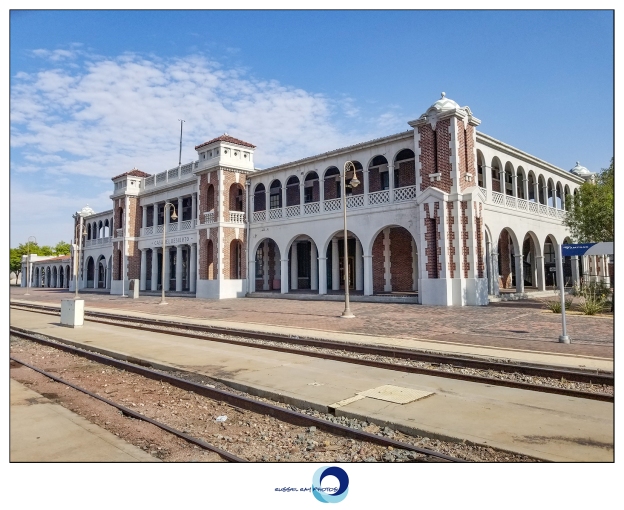
When I went on my journey in late July 2018, I originally had no idea where I was going. I just wanted to get out of California. When I got to Arizona, I slowed down and decided to visit places that I had not been in 50 years, and in a couple of cases, where I had never been. I combined my love of history, nature, and railroads.
That put Barstow, California, high on my list, with its railroad and car history and its position in the Mojave Desert. When I got there, I got a hotel room just a couple of blocks from the Barstow railroad yard, unloaded things, and then walked down to the rail yard to watch some trains.
When I got there, I saw the most beautiful train station.

Since I had arrived late in the day, the station was closed. I walked around the station until sunset and discovered a historical marker outside. This station was a Harvey House. Wow. I didn’t know any still existed.

The plaque reads:
Harvey Houses were legendary in the history of western rail travel. Operated by Fred Harvey in conjunction with the Santa Fe Railway. The network of restaurant-hotels set a new standard in quality meal service. Barstow’s Spanish-Moorish “Casa del Desierto,” opened in 1911 and closed in 1971. It was registered as one of the last and finest remaining examples of the West’s famous Harvey Houses.
The first paragraph in the Wikipedia entry tells more:
The Fred Harvey Company was the owner of the Harvey House chain of restaurants, hotels, and other hospitality industry businesses alongside railroads in the western United States. It was founded in 1876 by Fred Harvey to cater to the growing number of train passengers. When Harvey died in 1901, his family inherited 45 restaurants and 20 dining cars in 12 states. By 1968, when it was sold to Amfac, Inc., the Fred Harvey Company turned into the sixth largest food retailer in the United States. It left behind a lasting legacy of good food, dedication to customers, decent treatment of employees, and preservation of local traditions.
There was history hanging on the walls inside.



Fred Harvey emigrated to the United States from England when he was 17 years old.
The first two Harvey Houses were simply eating houses in Wallace, Kansas, and Hugo, Colorado, serving customers of the Kansas Pacific Railway, opened while Fred Harvey was a freight agent for the Chicago, Burlington & Quincy Railroad. Although the two eating houses were closed within a year, Harvey was convinced of the potential for providing high quality food and service at railroad eating houses.
Harvey approached the Burlington Railroad, which declined his offer to establish a system-wide eating house operation. The Santa Fe Railway, however, contracted with him for several eating houses on an experimental basis. The first eating house on the Santa Fe Railway was established in 1876 in Topeka, Kansas, under terms of an oral agreement. Both railroad officials and passengers were impressed with Harvey’s standards for high quality food and service. Santa Fe’s subsequent contracts with Harvey provided unlimited funds to set up eating houses along most of Santa Fe’s routes. Some of the eating houses at more prominent locations evolved into hotels. By the late 1880s, Harvey dining facilities were located at least every 100 miles along the railroad.
Harvey is credited with creating the first restaurant chain in the United States. (Now we know who to blame!) Harvey and his company became leaders in promoting tourism in the American Southwest in the late 19th century. The “wild wild west” was tamed, at least along the railroad tracks, by Harvey, his company, and its employees, the waitresses who came to be known as Harvey Girls.
Before dining cars, rail passengers patronized roadhouses located near water stops for steam locomotives. Food fare often consisted of rancid meat, cold beans, and week-old coffee, discouraging many from making the journey westward.
Meals were served in large portions, providing a good value for the traveling public. Pies were cut into fourths instead of the industry standard sixths. Eating houses could feed an entire train in just thirty minutes, and meals meals were served on fine China and Irish linens.
Harvey employed only white females on its serving staff, advertising in newspapers throughout the East Coast and Midwest for “white, young women, 18-30 years of age, of good character, attractive and intelligent”. Girls were paid $18.50 a month plus room and board, generous at the time. Women, eventually becoming known as Harvey Girls, were subjected to a 10:00 p.m. curfew and wore starched black and white skirts hanging no more than eight inches off the floor, with “Elsie” collars, opaque black stockings, and black shoes completing the uniform. Hair was restrained in a net and tied with a regulation white ribbon. Makeup was prohibited, as was chewing gum while on duty.
Harvey Girls entered into a one-year employment contract, forgetting half their base pay should they fail to complete the year, which happened most often due to marriage.
The opportunity to leave their homes, enjoy travel, have new experiences, and work outside the home was liberating for thousands of young women.
One of the wall hangings was about the 1946 movie, “Harvey House,” starring Judy Garland, Angela Lansbury, and Ray Bolger. Movie buffs should recognize those names.

When Fred Harvey died in 1901, his company operated 47 restaurants, 15 hotels, and 30 dining cars. The Fred Harvey Company continued into the 1960s under direction of Harvey’s son and grandson. In 1968, the company was purchased by Amfac Parks & Resorts, renamed Xanterra Parks & Resorts in 2002. Xanterra still operates three Harvey Houses: El Tovar Hotel (built 1905) and Bright Angel Lodge (built 1908) on the South Rim of the Grand Canyon, and the Fray Marcos Hotel (built 1908) in Williams, Arizona, which serves as the train depot and hotel for the Grand Canyon Railway.
I was hoping to ride the Grand Canyon Railway from Williams to the Grand Canyon, a distance of about 60 miles, but the train leaves early in the morning, and since I still had time to drive to the Grand Canyon, that’s what I did. Sadly, I did not know anything about Williams so I did not get pictures of the depot and hotel.
I got a picture of El Tovar Hotel at the South Rim. It’s hard to miss the hotel, although I did not know what it was at the time, either.

Barstow originally served the Atchison, Topeka & Santa Fe Railway. Today, the historic yard serves BNSF, Union Pacific, and Amtrak.Only two tracks remain for passenger trains, both used by Amtrak’s Southwest Chief.

While I was hanging around, an Amtrak train pulled. Totally unexpected. Hundreds of people got off the train, stretched, walked around, drank coffee, and smoked cigarettes. After about five minutes, everyone got back on the train and it took off. Strangest. stop. ever.
I talked to a couple of Amtrak employees on the train while people were getting back on board, and it turns out that the train, every seat occupied, was stuck in the high desert for twelve hours when a thunderstorm washed away some tracks. Passengers obviously were a little stressed and tired; since the train already was twelve hours late, letting everyone get off and relax for five minutes was a no-brainer. Here’s a video of the train arriving:
The Barstow Harvey House was closed as a train station in 1971, and closed permanently in 1973. It was added to the National Register of Historic Places in 1975 and named a California Historic Landmark in 1976. The City of Barstow bought it in 1990 after it had sat vacant and neglected for 17 years. It was heavily damaged in the 1992 7.3 magnitude Landers Earthquake. Restoration required more than $8 million in repairs. Currently, the building houses the Barstow Area Chamber of Commerce & Visitor Center, the Western America Railroad Museum, the Route 66 “Mother Road” Museum, and rotating and traveling exhibits.
There is a beautiful bridge over the rail yard which allows for the most beautiful of sunset pictures.





From my research, I found that there were 84 Harvey Houses. I could not find a definitive number for those which remain, but apparently it is less than ten. Casa del Desierto, the House of the Desert, is considered the finest remaining example of a Harvey House.
More pictures:














